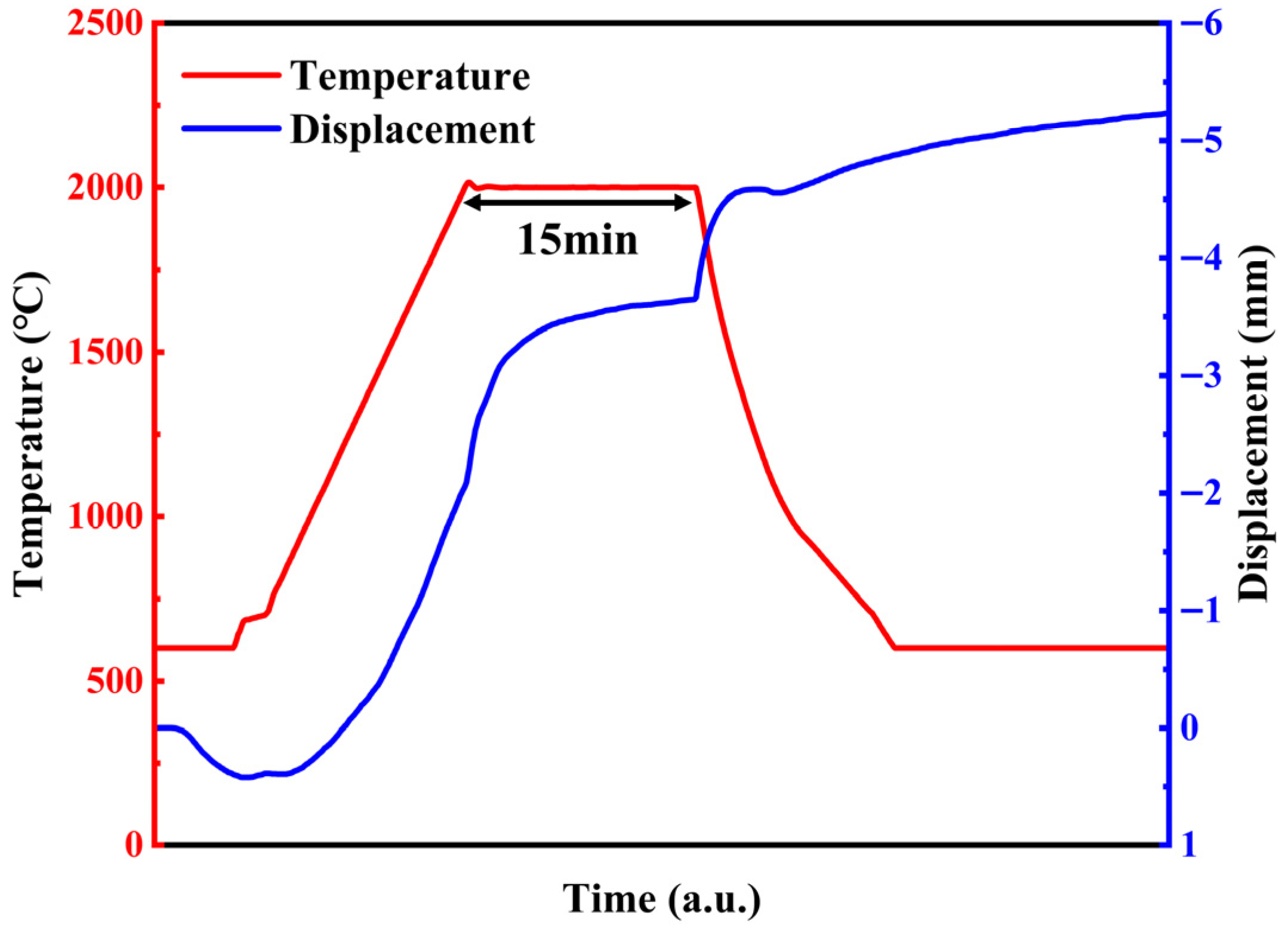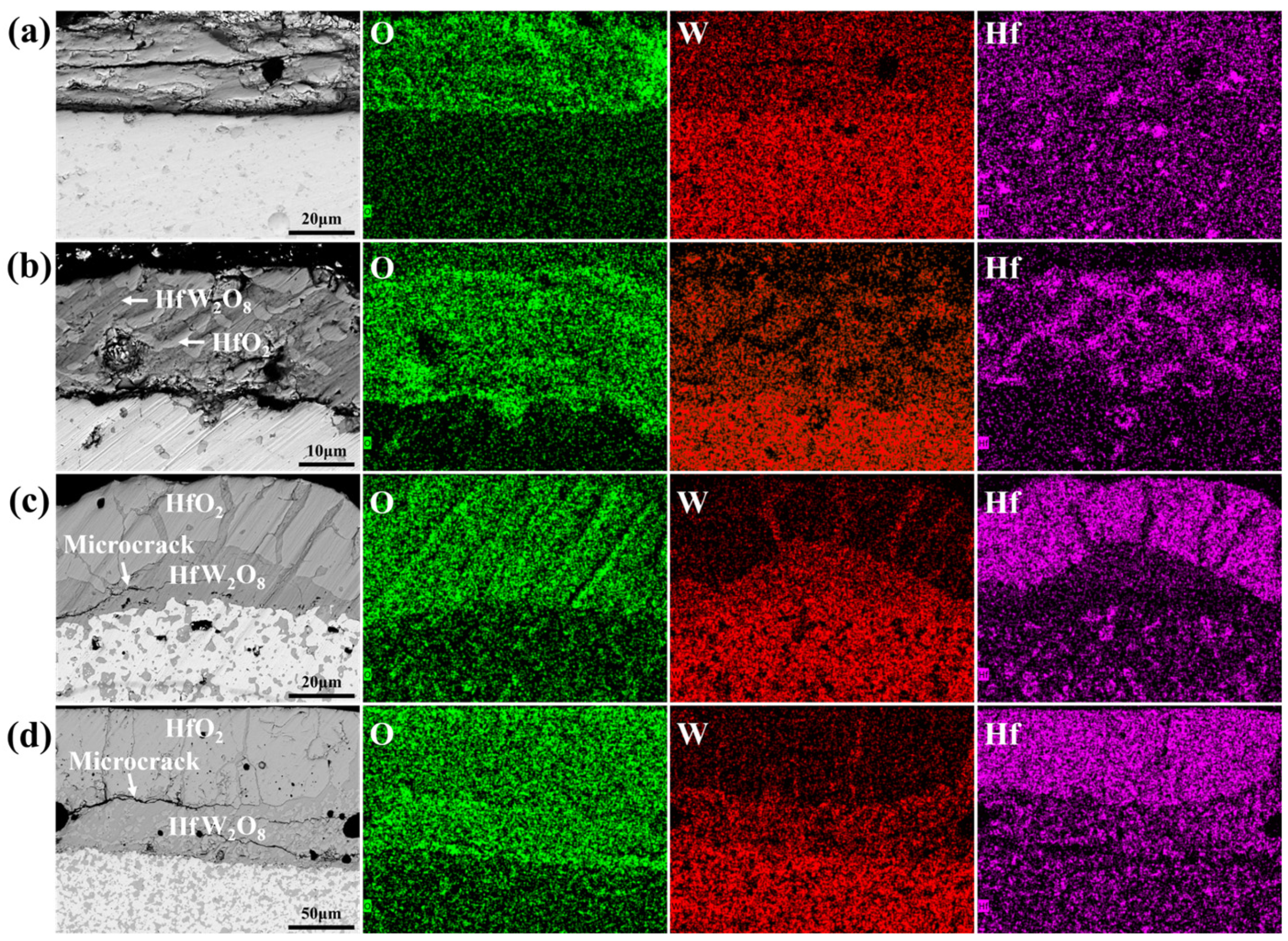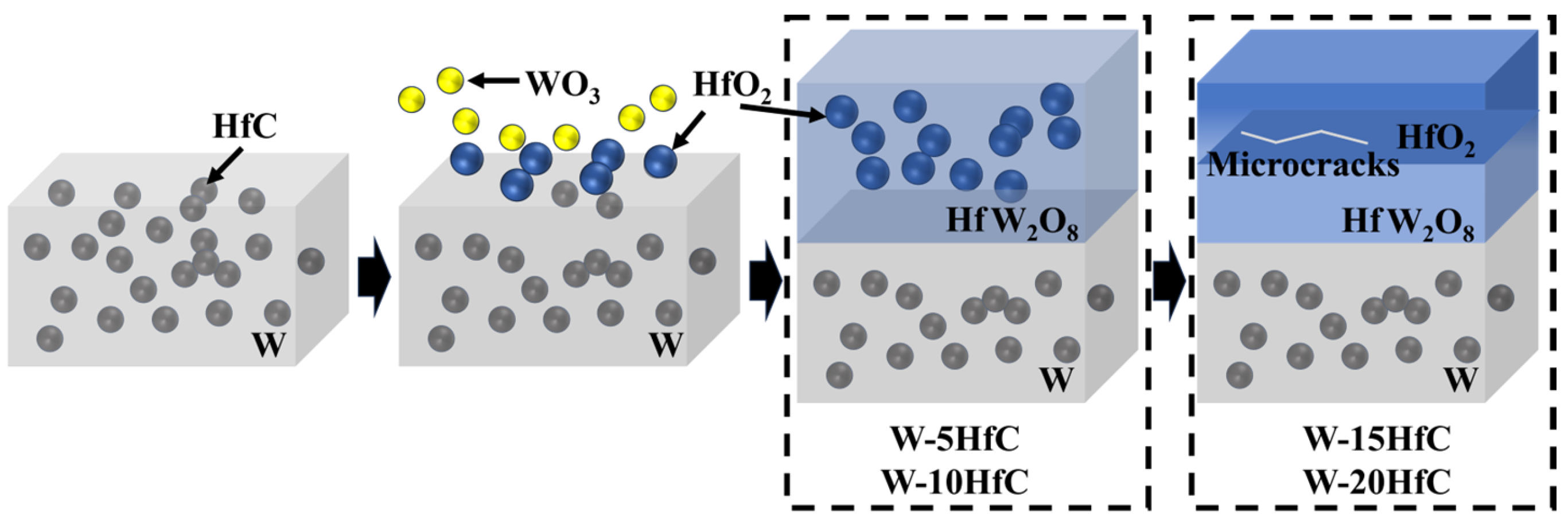Effect of HfC Content on the Elevated-Temperature Ablation Behavior of W-HfC Composites
Abstract
1. Introduction
2. Materials and Methods
3. Results and Discussion
3.1. Ablation Properties
3.2. Ablated Microstructure
3.3. Ablation Mechanisms
4. Conclusions
- (1)
- For insufficient HfC content (5 wt%), the dominant ablation product of W-HfC composites is HfW2O8, with limited HfO2 formation during high-temperature ablation. The sparse HfO2 distribution fails to effectively block heat flux and oxygen ingress. The W-5HfC composite exhibits a linear ablation rate of 0.0208 mm/s.
- (2)
- Optimal ablation resistance is achieved at 10 wt% HfC content with a minimized linear ablation rate of 0.0175 mm/s. The W-10HfC composite forms HfW2O8 with negative thermal expansion coefficients and uniformly dispersed HfO2 blocks during ablation. The dense oxide layer, featuring strong interfacial bonding between HfW2O8 and HfO2, effectively impedes heat and oxygen penetration, thereby enhancing ablation resistance.
- (3)
- Excessive HfC additions (15, 20 wt%) promote excessive HfO2 formation, which aggregates and migrates outward, forming a layered structure with HfW2O8. The thermal expansion mismatch between these oxides induces microcracks, accelerating heat flux and oxygen infiltration, and degrading ablation performance.
Author Contributions
Funding
Data Availability Statement
Conflicts of Interest
References
- Federici, G.; Zhitlukhin, A.; Arkhipov, N.; Giniyatulin, R.; Klimov, N.; Landman, I.; Podkovyrov, V.; Safronov, V.; Loarte, A.; Merola, M. Effects of ELMs and disruptions on ITER divertor armour materials. J. Nucl. Mater. 2005, 337–339, 684–690. [Google Scholar] [CrossRef]
- Xie, X.F.; Xie, Z.M.; Liu, R.; Fang, Q.F.; Liu, C.S.; Han, W.Z.; Wu, X.B. Hierarchical microstructures enabled excellent low-temperature strength-ductility synergy in bulk pure tungsten. Acta Mater. 2022, 228, 117765. [Google Scholar] [CrossRef]
- Ren, C.; Fang, Z.Z.; Xu, L.; Ligda, J.P.; Paramore, J.D.; Butler, B.G. An investigation of the microstructure and ductility of annealed cold-rolled tungsten. Acta Mater. 2019, 162, 202–213. [Google Scholar] [CrossRef]
- Dong, Z.; Ma, Z.; Yu, L.; Liu, Y. Achieving high strength and ductility in ODS-W alloy by employing oxide@W core-shell nanopowder as precursor. Nat. Commun. 2021, 12, 5052. [Google Scholar] [CrossRef]
- Ma, S.; Dong, D.; Zhang, M.; Gao, Y.; Wu, Z.; Wang, D. Enhanced ultra-high temperature creep resistance originating from preferred microstructures of W-Re-HfC alloys. Mater. Charact. 2024, 218, 14585. [Google Scholar] [CrossRef]
- Dong, B.W.; Li, Z.R.; Wu, Z.P.; Zhou, Z.Y.; Liu, S.C.; Zhao, W.L.; Mao, C.R.; Li, L.Y.; Liu, J.M.; Jie, J.C. Novel insight into relationship between microstructure and ablation behavior of Cu-W alloys prepared by melt infiltration: Experiments and molecular dynamics. Compos. Struct. 2025, 363, 119126. [Google Scholar] [CrossRef]
- Liu, X.X.; Zhu, J.P.; Jin, W.; Jiang, C.L.; Zhang, X.D.; Wang, J.W.; Ye, X.Q.; Chen, C.G. The transport, retention, and distribution behavior of deuterium in W-Ni-Fe alloys. Mater. Sci. Eng. A 2025, 931, 148223. [Google Scholar] [CrossRef]
- Gao, Q.; Lu, Z.L.; Li, Y.L.; Ding, Y.H.; Chen, Q.Y.; Li, H.; Xu, H.X.; Cui, X.Y.; Sun, T.T. Effect of different composition ratio on mechanical properties of W-Fe-B alloy. Int. J. Refract. Met. Hard Mater. 2025, 130, 107181. [Google Scholar] [CrossRef]
- Wesemann, I.; Spielmann, W.; Heel, P.; Hoffmann, A. Fracture strength and microstructure of ODS tungsten alloys. Int. J. Refract. Met. Hard Mater. 2010, 28, 687–691. [Google Scholar] [CrossRef]
- Kang, K.J.; Zhang, L.M.; Luo, G.Q.; Zhang, J.; Tu, R.; Wu, C.D.; Shen, Q. Microstructural evolution and mechanical behavior of W-Si-C multi-phase composite prepared by arc-melting. Mater. Sci. Eng. A 2018, 712, 28–36. [Google Scholar] [CrossRef]
- Xiao, F.N.; Miao, Q.; Wei, S.Z.; Li, Z.; Sun, T.L.; Xu, L.J. Microstructure and mechanical properties of W-ZrO2 alloys by different preparation techniques. J. Alloys Compd. 2019, 774, 210–221. [Google Scholar] [CrossRef]
- Wang, Y.K.; Miao, S.; Xie, Z.M.; Liu, R.; Zhang, T.; Fang, Q.F.; Hao, T.; Wang, X.P.; Liu, C.S.; Liu, X.; et al. Thermal stability and mechanical properties of HfC dispersion strengthened W alloys as plasma-facing components in fusion devices. J. Nucl. Mater. 2017, 492, 260–268. [Google Scholar] [CrossRef]
- Mattern, A.; Huchler, B.; Staudenecker, D.; Oberacker, R.; Nagel, A.; Hoffmann, M.J. Preparation of interpenetrating ceramic–metal composites. J. Eur. Ceram. Soc. 2004, 24, 3399–3408. [Google Scholar] [CrossRef]
- Huang, Y.T.; Li, X.W.; Zha, Y.F.; Zhou, X.L.; Peng, D.L.; Hua, N.B.; Chen, W.Z. Fabrication and high temperature tribological properties of WC reinforced W-Cu composites. Mater. Today Commun. 2021, 28, 102550. [Google Scholar] [CrossRef]
- Zhang, H.; Liu, J.R.; Zhang, G.H. Preparation and properties of W-30 wt% Cu alloy with the additions of Ni and Fe elements. J. Alloys Compd. 2022, 928, 167040. [Google Scholar] [CrossRef]
- Dong, L.L.; Fu, Y.Q.; Liu, Y.; Lu, J.W.; Zhang, W.; Huo, W.T.; Jin, L.H.; Zhang, Y.S. Interface engineering of graphene/copper matrix composites decorated with tungsten carbide for enhanced physico-mechanical properties. Carbon 2021, 173, 41–53. [Google Scholar] [CrossRef]
- Li, J.F.; Cheng, J.G.; Wei, B.Z.; Zhang, M.L.; Luo, L.M.; Wu, Y.C. Microstructure and properties of La2O3 doped W composites prepared by a wet chemical process. Int. J. Refract. Met. Hard Mater. 2017, 66, 226–233. [Google Scholar] [CrossRef]
- Kang, K.J.; Tu, R.; Luo, G.Q.; Zhang, J.; Zhu, J.W.; Shen, Q.; Zhang, L.M. Synergetic effect of Re alloying and SiC addition on strength and toughness of tungsten. J. Alloys Compd. 2018, 767, 1064–1071. [Google Scholar] [CrossRef]
- Miao, S.; Xie, Z.M.; Yang, X.D.; Liu, R.; Gao, R.; Zhang, T.; Wang, X.P.; Fang, Q.F.; Liu, C.S.; Luo, G.N.; et al. Effect of hot rolling and annealing on the mechanical properties and thermal conductivity of W-0.5wt.% TaC alloys. Int. J. Refract. Met. Hard Mater. 2016, 56, 8–17. [Google Scholar] [CrossRef]
- Deng, H.W.; Xie, Z.M.; Wang, Y.K.; Liu, R.; Zhang, T.; Hao, T.; Wang, X.P.; Fang, Q.F.; Liu, C.S. Mechanical properties and thermal stability of pure W and W-0.5wt%ZrC alloy manufactured with the same technology. Mater. Sci. Eng. A 2018, 715, 117–125. [Google Scholar] [CrossRef]
- Bu, X.J.; He, P.F.; Zhang, P.; Sun, C.; Liang, X.B.; Xing, Y.; Duan, X.M.; Wang, Y.J.; Hu, Z.F. In-situ formation and ablation mechanism of dense and multilayered ZrB2-ZrSi2-MoSi2 ultra-high temperature ceramic composite coating on Ta-W alloy under plasma blame beyond 2000 °C. Corros. Sci. 2024, 237, 112316. [Google Scholar] [CrossRef]
- Wang, H.; Xie, Z.; Cheng, X.; Jing, K.; Zhang, L.; Yang, J. Microstructural evolution and thermal fatigue damage mechanism of second-phase dispersion strengthened tungsten composites under repetitive thermal loads. J. Mater. Sci. Technol. 2023, 140, 221–232. [Google Scholar] [CrossRef]
- Wang, Y.; Wang, D.; Zhang, T.; Song, G.M.; Chen, L.; Wei, B.X.; Zhao, Y.W.; Zhou, Y. Refractory carbide reinforced tungsten matrix composites. J. Alloys Compd. 2022, 925, 166342. [Google Scholar] [CrossRef]
- Wei, Y.N.; Chen, Y.; Ma, M.F.; Zhu, L.H.; Li, Y.R.; Guo, B.B. Investigation on microstructure and reinforcement mechanism of the TiC-reinforced W-matrix composite prepared by high-energy ball milling and spark plasma sintering. Vacuum 2024, 220, 112841. [Google Scholar] [CrossRef]
- Lee, D.J.; Umer, M.A.; Ryu, H.J.; Hong, S.H. Elevated temperature ablation resistance of HfC particle-reinforced tungsten composites. Int. J. Refract. Met. Hard Mater. 2014, 43, 89–93. [Google Scholar] [CrossRef]
- Zhang, J.; Ma, S.; Zhu, J.; Kang, K.; Luo, G.; Wu, C.; Shen, Q.; Zhang, L. Microstructure and Compression Strength of W/HfC Composites Synthesized by Plasma Activated Sintering. Met. Mater. Int. 2019, 25, 416–424. [Google Scholar] [CrossRef]
- Sun, B.Z.; Gao, L.; Lou, L.H.; Li, R.; Song, J.P.; Liu, Y.L.; Qi, Y. Microstructure and mechanical properties of W-HfC alloy synthesized by in-situ fabrication via pressureless sintering. Int. J. Refract. Met. Hard Mater. 2025, 127, 106978. [Google Scholar] [CrossRef]
- Zhou, Y.M.; Tang, Z.X.; Liu, R.Z.; Zhou, Z.; Yi, M.Z.; Peng, K. Preparation and ablation behavior of solid solution ceramic Ta0.2Zr0.8C-SiC matrix-modified C/C composites under high heat flux. J. Mater. Res. Technol. 2025, 35, 1875–1888. [Google Scholar] [CrossRef]
- Xiao, P.; Wang, S.; Yu, Y.P.; Fang, B.; Li, H. Improved toughness of HfC with tantalum fibre net and tantalum foil. Ceram. Int. 2021, 47, 19260–19266. [Google Scholar] [CrossRef]
- Yamamura, Y.; Nakajima, N.; Tsuji, T.; Iwasa, Y.; Saito, K.; Sorai, M. Heat capacity and Grüneisen function of negative thermal expansion compound HfW2O8. Solid State Commun. 2002, 121, 213–217. [Google Scholar] [CrossRef]
- Liu, H.F.; Wang, G.; Zhang, Z.P.; Pan, K.M.; Zeng, X.H. Synthesis of negative thermal expansion HfW2O8 thin film using pulsed laser deposition. Ceram. Int. 2014, 40, 13855–13859. [Google Scholar] [CrossRef]
- Wang, J.; Li, H.P.; Stevens, R. Hafnia and hafnia-toughened ceramics. J. Mater. Sci. 1992, 27, 5397–5430. [Google Scholar] [CrossRef]






| Composites | Relative Density (%) | Thickness (mm) | Burn-Through Time (s) | Linear Ablative Rate (mm/s) |
|---|---|---|---|---|
| W-5HfC | 98.2 | 5.1 | 245 | 0.0208 |
| W-10HfC | 99.9 | 5.3 | 302 | 0.0175 |
| W-15HfC | 99.9 | 5.1 | 241 | 0.0211 |
| W-20HfC | 97.1 | 5.2 | 224 | 0.0232 |
Disclaimer/Publisher’s Note: The statements, opinions and data contained in all publications are solely those of the individual author(s) and contributor(s) and not of MDPI and/or the editor(s). MDPI and/or the editor(s) disclaim responsibility for any injury to people or property resulting from any ideas, methods, instructions or products referred to in the content. |
© 2025 by the authors. Licensee MDPI, Basel, Switzerland. This article is an open access article distributed under the terms and conditions of the Creative Commons Attribution (CC BY) license (https://creativecommons.org/licenses/by/4.0/).
Share and Cite
Zheng, B.; Song, C.; Wu, Y.; Du, Z.; Du, L.; Zhang, B.; Hui, X. Effect of HfC Content on the Elevated-Temperature Ablation Behavior of W-HfC Composites. Metals 2025, 15, 925. https://doi.org/10.3390/met15080925
Zheng B, Song C, Wu Y, Du Z, Du L, Zhang B, Hui X. Effect of HfC Content on the Elevated-Temperature Ablation Behavior of W-HfC Composites. Metals. 2025; 15(8):925. https://doi.org/10.3390/met15080925
Chicago/Turabian StyleZheng, Boyuan, Chaoqian Song, Yidong Wu, Zhong Du, Liye Du, Baohong Zhang, and Xidong Hui. 2025. "Effect of HfC Content on the Elevated-Temperature Ablation Behavior of W-HfC Composites" Metals 15, no. 8: 925. https://doi.org/10.3390/met15080925
APA StyleZheng, B., Song, C., Wu, Y., Du, Z., Du, L., Zhang, B., & Hui, X. (2025). Effect of HfC Content on the Elevated-Temperature Ablation Behavior of W-HfC Composites. Metals, 15(8), 925. https://doi.org/10.3390/met15080925






